
AMD Radeon RX 560 Review: Faster And Cheaper Than The Competition
Introduction
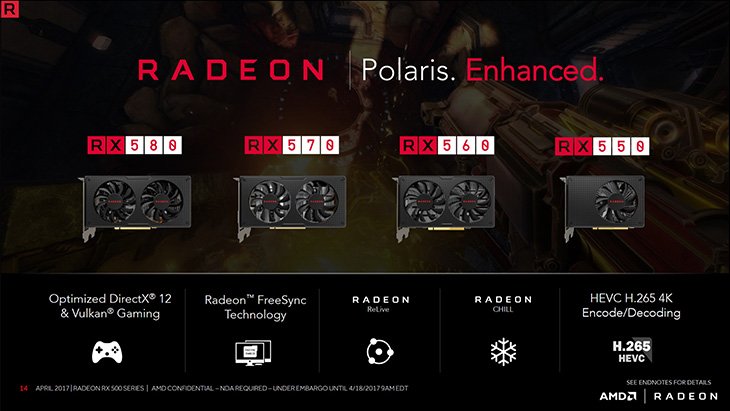
AMD launched the RX 560 back in May with the 2GB model priced at $100 and 4GB model priced at $110. The launch of the RX 500 series is based on refined versions of the Polaris 10 and 11 architectures with the exception of the RX 550 which is based on a new Polaris 12 chip. We have already covered the RX 550 and the RX 570 and RX 580 in-depth and we have found these cards to offer much better performance than the competition.
Today we will be looking at the RX 560 which closes the performance gap between eSports and modern AAA titles which require every bit of performance. While the RX 550 is a card aimed at eSports gamers and is about $20 cheaper than the RX 560, the RX 560 has almost double the hardware specifications so the performance increase is huge. AMD has positioned the Radeon RX 560 to compete directly against the GTX 1050 and in this review, we will pit these two cards together to see which one is the better card.
Something to keep in mind about the RX 500 series is that the RX 500 series was designed specifically for gamers who are on a 2 year old graphics card and have not made the move to 14nm technology. The RX 500 series is meant mostly for people with older graphics cards such as the Radeon 300/200 or GTX 900 series.
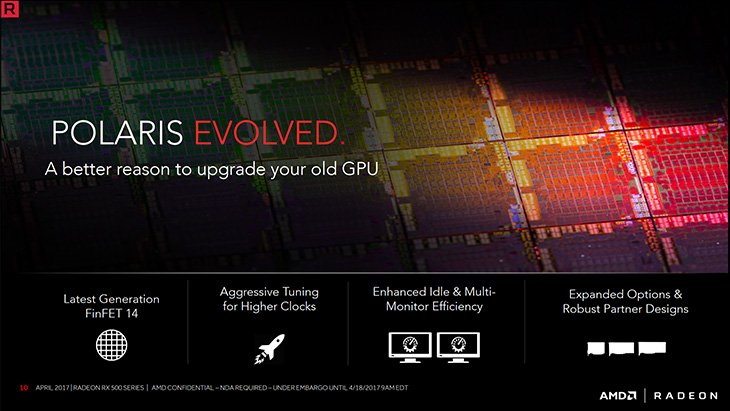
If you are a gamer that is still running a Radeon 300 or GTX 900 series card then there's really no reason not to upgrade to a RX 500 or GTX 1000 series at this point. Although, keep in mind that with the RX 500 series you have the option for crossfire for an additional boost. Whereas with the GTX 1000 series, NVIDIA has disabled SLI support from everything below the GTX 1070. Also, another thing to consider is that AMD is ahead of NVIDIA in drivers and newer games support and AMD's cards get much better with time compared to Nvidia's cards.
Specifications
| AMD Radeon RX 500 Series Lineup | ||||
|---|---|---|---|---|
| Model: | Radeon RX 550 | Radeon RX 560 | Radeon RX 570 | Radeon RX 580 |
| Process Node: | 14nm FinFET | 14nm FinFET | 14nm FinFET | 14nm FinFET |
| GPU Model: | Polaris 12 (Lexa Pro) | Polaris 21 (Baffin Pro) | Polaris 20 XL (Ellesmere Pro) | Polaris 20 XLX (Ellesmere XT) |
| Architecture: | 4th Gen GCN | 4th Gen GCN | 4th Gen GCN | 4th Gen GCN |
| Cores: | 512 | 1024 | 2048 | 2304 |
| Base Clock: | 1100 MHz | 1090 MHz | 1168 MHz | 1257 MHz |
| Boost Clock: | 1183 MHz | 1287 MHz | 1244 MHz | 1340 MHz |
| Compute Units: | 8 | 16 | 32 | 36 |
| Memory Clock (Effective): | 1750 (7000) MHz | 1750 (7000) MHz | 1750 (7000) MHz | 2000 (8000) MHz |
| Computing Power (FP32): | 1,126 GFLOPS | 2,232 GFLOPS | 4,784 GFLOPS | 5,788 GFLOPS |
| Memory Size: | 2GB GDDR5 | 2GB GDDR5 | 4GB GDDR5 | 8GB GDDR5 |
| TDP: | 50W | 80W | 150W | 185W |
| Memory Bus Width: | 128-bit | 128-bit | 256-bit | 256-bit |
| Memory Bandwidth: | 112 GB/s | 112 GB/s | 224 GB/s | 256 GB/s |
| Interface: | PCIe 3.0 x8 | PCIe 3.0 x8 | PCIe 3.0 x16 | PCIe 3.0 x16 |
| Transistors: | 2.2 Billion | 3 Billion | 5.7 Billion | 5.7 Billion |
| Die size: | 101 mm² | 123 mm² | 232 mm² | 232 mm² |
| TMUs: | 32 | 64 | 128 | 144 |
| ROPs: | 16 | 16 | 32 | 32 |
| Pixel Rate: | 18.93 GPixel/s | 20.40 GPixel/s | 39.8 GPixel/s | 42.9 GPixel/s |
| Texture Rate: | 37.9 GTexel/s | 81.6 GTexel/s | 159.2 GTexel/s | 193.0 GTexel/s |
| Price: | $79 | $99 | $169 | $229 |
| Release Date: | April 20, 2017 | May 17, 2017 | April 18, 2017 | April 18, 2017 |
The Radeon RX 560 is built using the Polaris 21, code-named Baffin Pro and it is based on a 4th gen GCN architecture. The Polaris 21 GPU has 16 CUs and 1024 cores instead of the 14 CUs and 896 cores found in the RX 460/Polaris 11. Other than that, the transistor count and die size remains the same so the transistor count is 3 billion and the die measures 232 square millimeters. It comes with a 80W TDP, 128-bit memory bus, and a 1090 MHz base with a 1287 MHz boost.
All the RX 500 series support features such as Radeon Chill which is a gameplay adaptive power saving feature, Radeon ReLive which can be used to capture, stream and share your greatest moments, AMD FreeSync Technology, HEVC 4K decoding, and also AMD Eyefinity Technology.
The Card
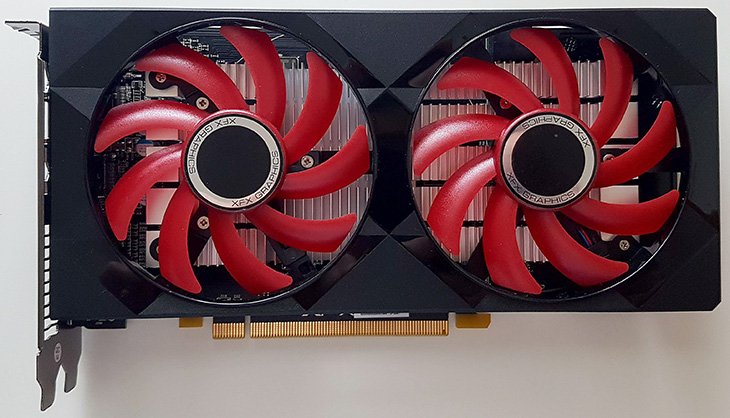
AMD has sent us the XFX RX 560 Double Dissipation OC 4GB card for this review. This card comes with a slight boost of 1295 MHz factory overclock which is a 1.6% increase over the reference design but it shouldn't make too much of a difference in performance. With factory overclocked cards, keep in mind that you're often paying for a better cooler rather than for the factory overclock.
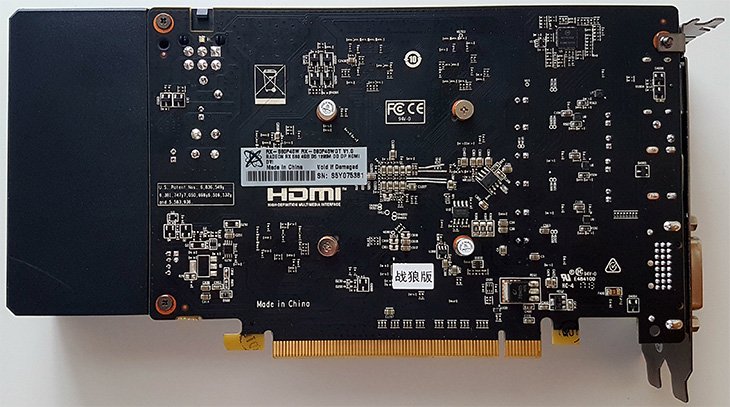
This is a dual slot card that measures 21.5cm x 9.5cm x 3.2cm and weighs around 400g. XFX has equipped this card with three display outputs, one HDMI 2.0b port, a Dual-Link DVI port, and one DisplayPort 1.4. As far as aesthetics and build quality go, this card will look great in any red and black build and it feels solidly built for the price. Looking at the card, we can see that it features a matte black PCB and the card itself is cooled by a large nickel-plated copper base plate without any heat pipes.
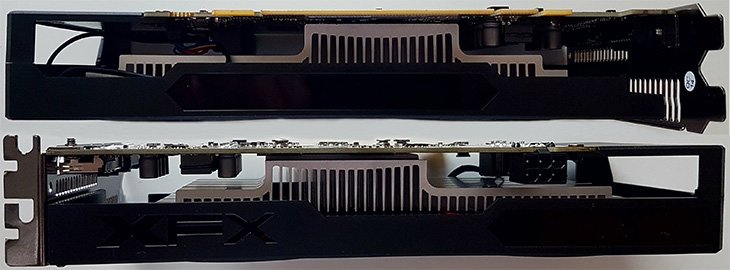
This XFX model is a 4GB model and it requires a 1 x 6-pin power connector but there are 4GB models out there that do not require a PCIe power connector so keep that in mind before you decide to purchase one. XFX indicates that a 350W is the recommended power supply requirement to run this card.
Test Setup
| Test Setup | |
|---|---|
| Processor: | AMD Ryzen 7 1700X |
| Motherboard: | MSI X370 xPower Gaming Titanium (BIOS Version 1.7) |
| RAM: | Crucial Ballistix Elite 3200MHz DDR4 16GB (2x8GB) |
| Graphics Card: | XFX RX 560 Double Dissipation 4GB MSI GTX 1050 2GB |
| Storage: | Crucial MX300 1TB SSD |
| Power Supply: | SilverStone Titanium ST80F-TI 800W |
| Case: | Open ATX Bench Case |
| OS: | Windows 10 64Bit |
| Thermal Compound: | Noctua NT-H1 |
| Heatsink: | Noctua NH-D15 |
Testing will be conducted by comparing the RX 560 against the NVIDIA GTX 1050 to see who offers the best gaming performance. We are using the latest available drivers for both cards at the time of writing this review. For the CPU, we have decided to use the Ryzen 7 1700X running at stock settings because it's a fantastic processors that offers excellent gaming performance at a much cheaper price compared to the competition. We also want to eliminate any CPU bottleneck as much as possible and the Ryzen 7 1700X can handle anything you throw at it.
All of the testing is done with an ambient temperature of ~22C and the processor has the power saving features disabled in the BIOS. Also, the testing was done on a fresh install of Windows 10 64-bit and we made sure there were as few processes running as possible by disabling a bunch of unnecessary services that come with Windows 10.
We will be testing all the games at 1080p and the settings will be set to high or medium depending
on how demanding the game is. Idle temperature will be measured after leaving the computer idle for 20 minutes with no
additional applications running in the background and load temperature will be measured by playing GTA V on high settings for 20 minutes at 1080p.
Gaming Benchmarks:
+ Rise of The Tomb Raider
+ Ashes of The Singularity
+ The Division
+ The Witcher 3
+ Mass Effect Andromeda
+ GTA V
+ Hitman 2016
+ DOOM
+ Battlefield 1
+ Deus Ex Mankind Divided
Temperature

I want to mention that the XFX RX 560 DD 4GB is a dual fan card while the MSI GTX 1050 2GB is a single fan card.
With that being said, the XFX RX 560 runs much cooler in both idle and load mode.
When leaving the computer at complete idle, the XFX RX 560 idles at around 34 Celsius while the MSI GTX 1050 idles at 37 Celsius.
During playing GTA V on high settings at 1080p, the temperature of the XFX RX 560 jumped to
around 54 Celsius and 59 Celsius for the MSI GTX 1050.
Gaming Performance Results
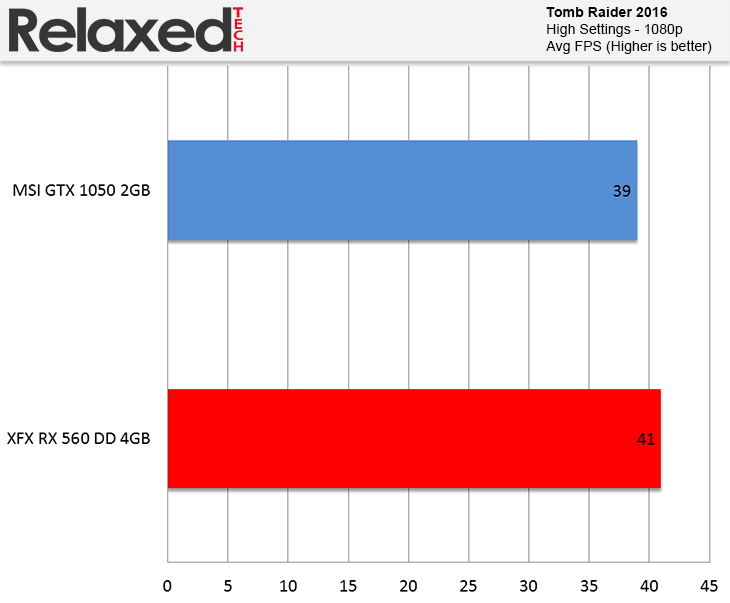
Looking at the Rise of The Tomb Raider benchmark, both cards performed similar but the RX 560 slightly pulled ahead.
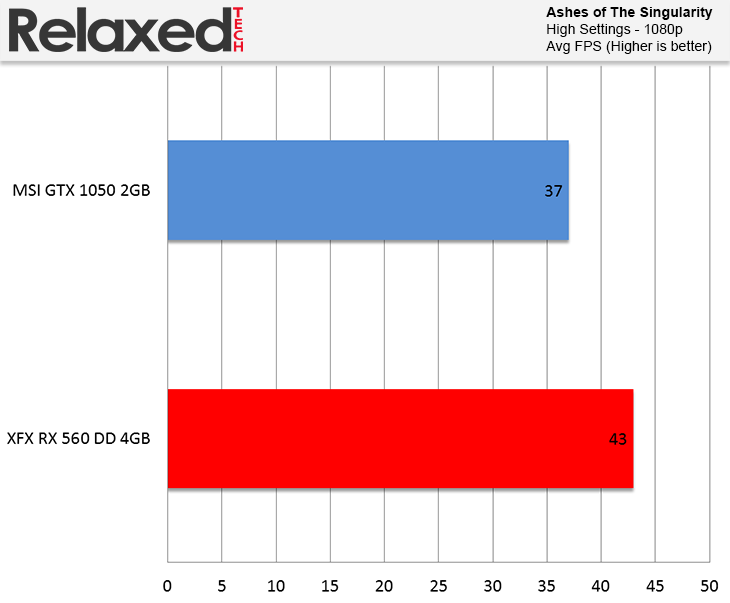
In Deus Ex Mankind Divided, the RX 560 crushed its competitor with a 6fps advantage.
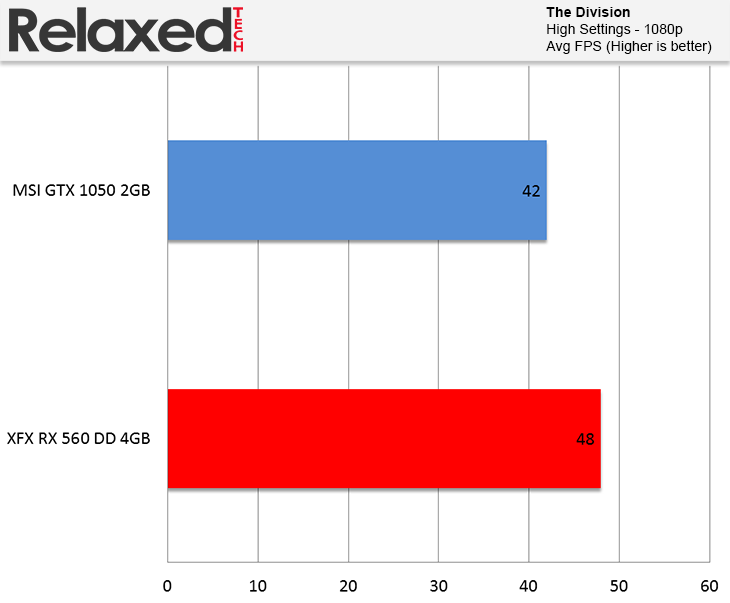
And we see the same thing in Ghost Recon Wildlands, the RX 560 outperforming the GTX 1050.
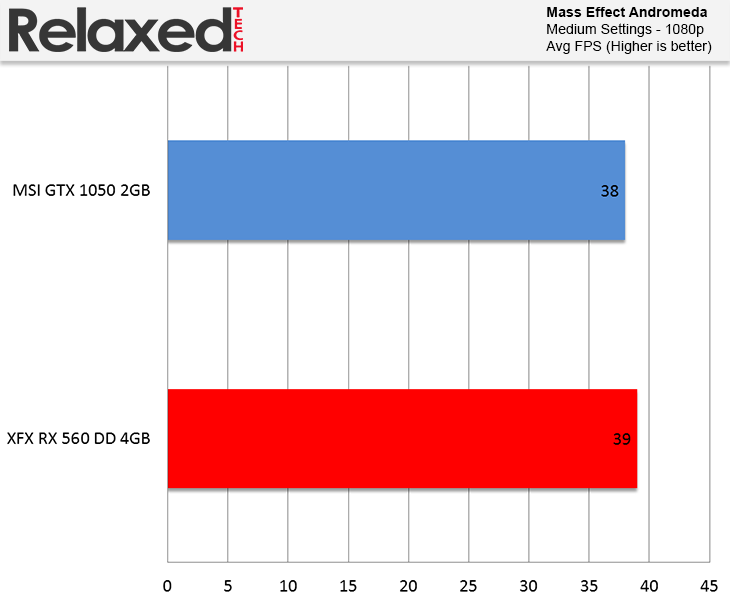
In Mass Effect Andromeda, both cards performed pretty much the same.
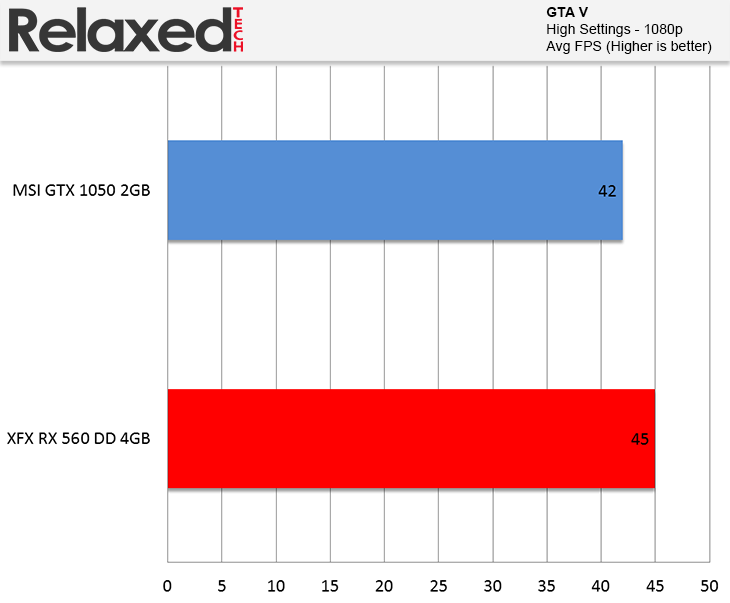
Moving on to GTA V, the Radeon RX 560 once again wrecked its competitor.
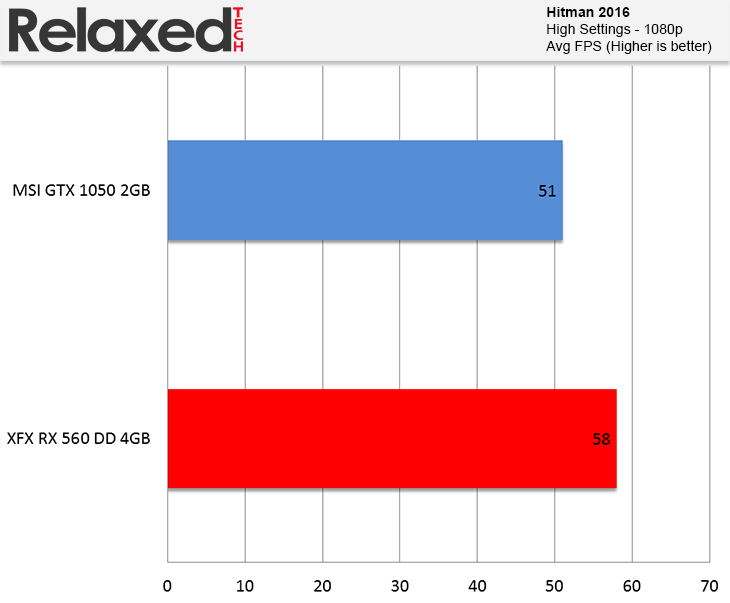
In Hitman 2016, the RX 560 decimated the GTX 1050.
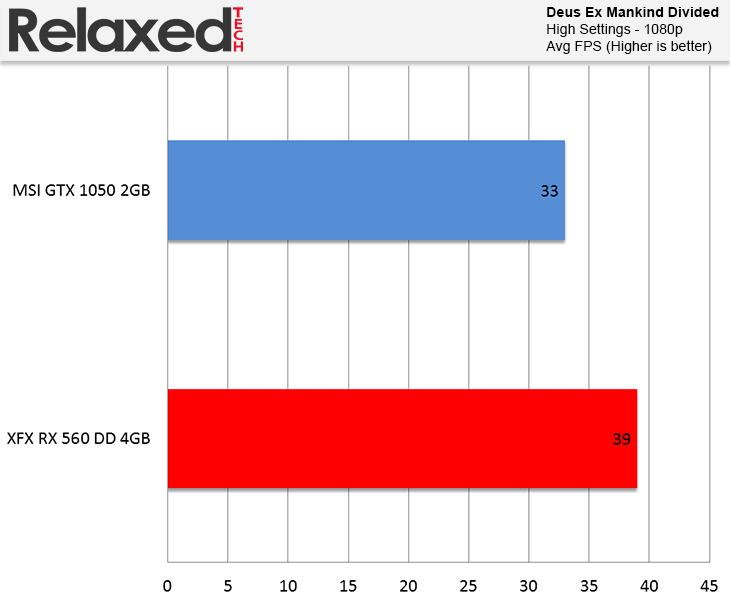
In Deus Ex Mankind Divided, the RX 560 performed much better than the GTX 1050.
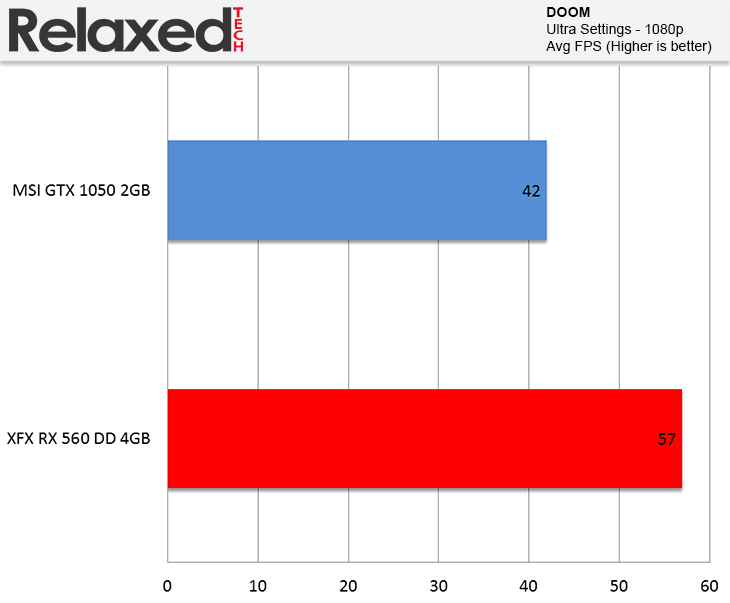
In DOOM, the RX 560 bulldozed the GTX 1050.
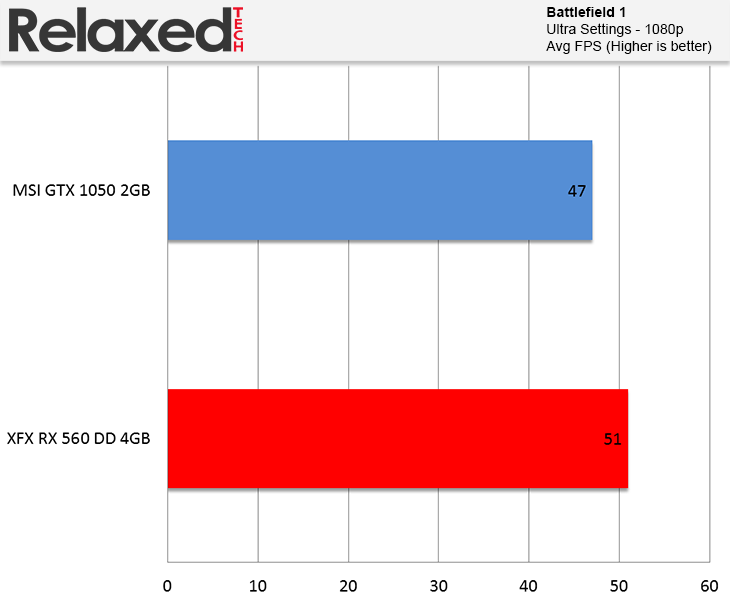
In Battlefield 1, the RX 560 obliterated the GTX 1050.
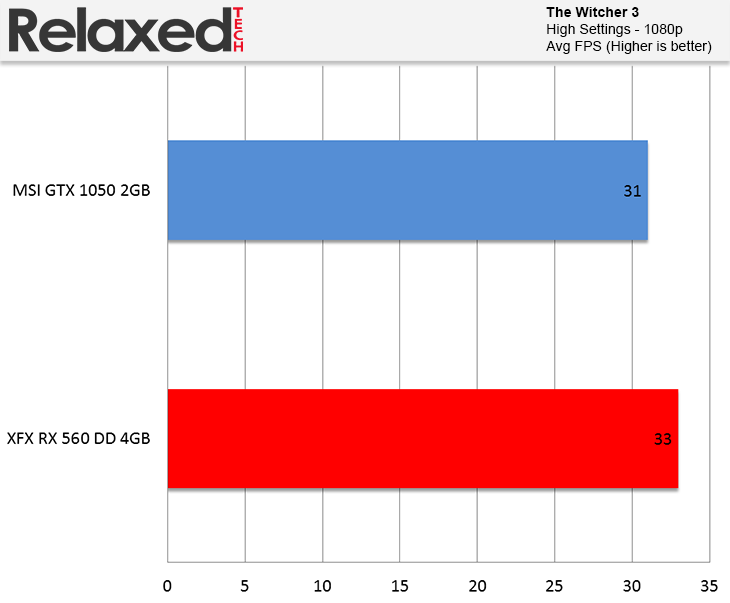
Last but not least, the RX 560 once again performed better than the GTX 1050 in The Witcher 3.
Value & Conclusion
The Radeon RX 560 offers a much better gaming performance in many popular titles and outperform its main competitor across a wide range of AAA games. The RX 560 is more than capable of delivering smooth gaming experience at 1080p with the settings set to medium. I found the RX 560 to be much faster than the GTX 1050 in pretty much every game that I tested.
If you are running an older graphics card such as the Radeon 300/200 or GTX 900 series, the RX 560 provides an excellent upgrade path and FreeSync gaming displays are much cheaper than Nvidia's G-Sync displays. The RX 560 delivers great 1080p gaming performance which easily surpasses the GTX 1050. The RX 560 comes with many modern technologies such as Free Sync, HDMI 2.0, DP 1.4 HBR, HEVC 4K decoding, Radeon Chill and Radeon ReLive.
If you are building a budget friendly gaming rig and want a strong entry-to-mid-range card for 720p/1080p gaming,
the RX 560 is more than capable of handling any game at 1080p with the settings set to medium.
The XFX RX 560 Double Dissipation runs relatively cool at 34 Celsius in idle mode and stay under 60 Celsius in heavy gaming.
Pros:
+ Fantastic Gaming Performance
+ Supports Modern Technologies
+ Factory Overclock
+ Faster Than Competition
+ Runs Quiet and Cool
Cons:
- XFX RX 560 DD Needs 1 x 6-Pin Connector
My only issue with the XFX RX 560 Double Dissipation 4GB is that it needs a 1 x 6-pin power connector. It does not make any sense for the RX 560 to require a 1 x 6-pin power connectors when the RX 460 never needed a PCIe connector. Other than that, the RX 560 is a fantastic card that performs exactly as advertised. As far as pricing goes, on Amazon and Newegg I can find the RX 560 to be anywhere from $5 to $15 cheaper than the GTX 1050. With all that being said, the Radeon RX 560 deserve our Gold Award.
Final Score 9.0
